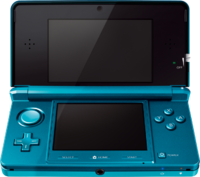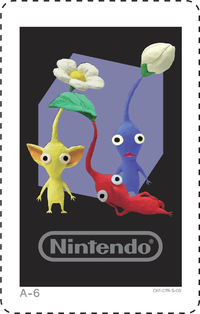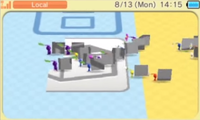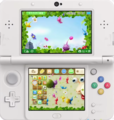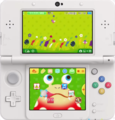Nintendo 3DS: Difference between revisions
m (Espyo moved page Nintendo 3DS to 3DS over redirect: Actually, let's do what Wikipedia does.) |
(Cleanup. I removed the New N3DS part because it's not really relevant, and the thing about Pikmin games being possible is speculation. Let's not dive into New N3DS info just yet.) |
||
| Line 1: | Line 1: | ||
{{Image|Get images of different models and the New Nintendo 3DS. Also, aren't there Japan exclusive Pikmin AR Cards? If so, add them.}} | {{Image|Get images of different models and the New Nintendo 3DS. Also, aren't there Japan exclusive Pikmin AR Cards? If so, add them.}} | ||
[[File:Nintendo 3DS.png|thumb|An Aqua Blue Nintendo 3DS.]] | [[File:Nintendo 3DS.png|thumb|An Aqua Blue Nintendo 3DS.]] | ||
The '''Nintendo 3DS''' is a handheld console developed by [[Nintendo]], released on February 26, 2011 in Japan, March 27, 2011 in North America, March 25, 2011 in Europe, and March 31, | The '''Nintendo 3DS''' is a handheld console developed by [[Nintendo]], released on February 26<sup>th</sup>, 2011 in Japan, March 27<sup>th</sup>, 2011 in North America, March 25<sup>th></sup>, 2011 in Europe, and March 31<sup>st</sup>, 2011 in Australia. It is the primary successor to the Nintedo DSi, and was first revealed at E3 2010. While the design of both systems are similar, the 3DS now features a control-stick style button known as the Circle Pad. | ||
The main gimmick behind the 3DS, like the name suggests, is its ability to display images in stereoscopic 3D without the use of 3D glasses. The 3D feature | The main gimmick behind the 3DS, like the name suggests, is its ability to display images in stereoscopic 3D without the use of 3D glasses. The 3D feature allows developers to add more depth and style to the games. For example, in ''[[Mariowiki:Super Mario 3D Land|Super Mario 3D Land]]'', certain 1-Up Mushrooms are actually just cardboard cutouts. The only easy way to tell the difference between the fakes and the real mushrooms is to turn on the 3D feature. While most games do not incorporate the 3D feature as a gameplay mechanic, it is regardless available for use. | ||
Like the DSi, Nintendo eventually released the 3DS XL, on July 28, 2012 in Japan, August 19, 2012 in North America, July 28, 2012 in Europe, and August 23, 2012 in Australia. The same aspects of the system return, except now the 3DS has been scaled up about 90% to allow those with bigger hands a more comfortable experience. Nintendo also released a 2DS, a version of the 3DS that is unable to use the 3D feature but still plays its games. The system is no longer foldable, and less portable. This was created likely so that | Like the DSi, Nintendo eventually released the 3DS XL, on July 28<sup>th</sup>, 2012 in Japan, August 19<sup>th</sup>, 2012 in North America, July 28<sup>th</sup>, 2012 in Europe, and August 23<sup>th</sup>, 2012 in Australia. The same aspects of the system return, except now the 3DS has been scaled up about 90%, to allow those with bigger hands a more comfortable experience. Nintendo also released a 2DS, a version of the 3DS that is unable to use the 3D feature but still plays its games. The system is no longer foldable, and less portable. This was created likely so that younger players could play the games without having the 3D effect harm their eyes. | ||
The 3DS is backwards compatible, meaning games for the DS and DSi are still playable on the 3DS. Toggling the 3D feature in a DS game, however, has no effect. The Circle Pad also cannot be used in DS games. | The 3DS is backwards compatible, meaning games for the DS and DSi are still playable on the 3DS. Toggling the 3D feature in a DS game, however, has no effect. The Circle Pad also cannot be used in DS games. In Japan and Australia, a successor to the 3DS was announced in 2014, in the form of the New Nintendo 3DS. | ||
In Japan and Australia, a successor to the 3DS was announced, in the form of the New Nintendo 3DS. | |||
==''Pikmin'' content== | ==''Pikmin'' content== | ||
[[File:Pikmin AR Card.png|thumb|right | [[File:Pikmin AR Card.png|thumb|right|The Pikmin AR Card.]] | ||
Bundled with the 3DS is a pack of AR Cards, one of which features a [[Red Pikmin|red]], [[Yellow Pikmin|yellow]], and [[blue Pikmin]]. These cards can be used in the built-in app AR Games, and in various software that supports AR Cards, like Tomadachi Life. This Pikmin AR Card can be used in the game | Bundled with the 3DS is a pack of AR Cards, one of which features a [[Red Pikmin|red]], [[Yellow Pikmin|yellow]], and [[blue Pikmin]]. These cards can be used in the built-in app AR Games, and in various software that supports AR Cards, like ''[[Nintendo:Tomodachi Life|Tomadachi Life]]''. This Pikmin AR Card can be used in the game ''Star Photos'', where the characters in the cards come to life. The player is able to take photos with them and the Question Mark Cube. The Pikmin have 5 different poses: | ||
#The red Pikmin is laying down, while the others are standing up. | #The red Pikmin is laying down, while the others are standing up. | ||
#The red and yellow Pikmin are running, and the blue Pikmin has tripped. | #The red and yellow Pikmin are running, and the blue Pikmin has tripped. | ||
#The 3 Pikmin are carrying a blue 1-[[Pellet]]. | #The 3 Pikmin are carrying a blue 1-[[Pellet]]. | ||
#The yellow and red Pikmin are planted, and the blue Pikmin stares at the sprouts. | #The yellow and red Pikmin are planted, and the blue Pikmin stares at the sprouts. | ||
#All 3 Pikmin join hands | #All 3 Pikmin join hands. | ||
[[File:DSTransfer.png|thumb|left|Pikmin carrying data over to the new system.]] | |||
When transfering downloadable content from DSi to 3DS, or 3DS to 3DS XL, various types of Pikmin are seen "[[carrying]]" the data over. | |||
''[[Pikmin 3]]'' was originally made for the [[Game Boy Advance]], and later Nintendo 3DS, but [[Shigeru Miyamoto]] wasn't happy with either of these consoles limitaitons for the game he envisioned. Eventually, he settled on using the [[Wii U]].<ref>[http://www.officialnintendomagazine.co.uk/50893/miyamoto-we-created-pikmin-on-3ds-and-gba/ Miyamoto: 'We created Pikmin on 3DS and GBA' - Official Nintendo Magazine]{{dead link|December|2014}}</ref> | |||
< | |||
</ | |||
The [[Pikmin Short Movies|''Pikmin'' Short Movies]] are available for purchase on both the 3DS and [[Wii U]] eShop. The 3DS version has images in 3D, while the Wii U version's video is in high quality. Although not belonging to the ''Pikmin'' canon, ''[[Super Smash Bros. for 3DS and Wii U|Super Smash Bros. for 3DS]]'' is a game on the 3DS. | |||
The | |||
{{clear}} | |||
Currently, there are two ''Pikmin''-related 3DS themes available on the 3DS Theme Shop. One is called "Working Together", and features a picture with the various Pikmin types on top. On the bottom, there is an animated image of various Pikmin working, being followed by a [[Red Bulborb]]. The second is called "Hungry Bulborb". This theme features many cartoon styled Pikmin on the top screen walking. On the bottom screen is a cartoon-styled Bulborb which will shift its eyes when the cursor on the bottom screen is moved. | |||
The | <gallery> | ||
File:WorkingTheme.png|The "Working Together" theme. | |||
File:HungryBulborbTheme.png|The "Hungry Bulborb" theme. | |||
</gallery> | |||
==Trivia== | ==Trivia== | ||
*The AR Card for Pikmin has a pose where | *The AR Card for Pikmin has a pose where three grounded Pikmin carry a 1-Pellet. Although not possible in any ''Pikmin'' game, the instruction manual in ''Pikmin'' contains an [[Prototype information#Other info|old screenshot]] showing such a feat. It is also possible in ''Pikmin'' with a [[Glitches in Pikmin#3 Pikmin carrying a 1 pellet|rare glitch]]. | ||
==References== | ==References== | ||
<references/> | <references/> | ||
[[Category:Consoles]] | [[Category:Consoles]] | ||
Revision as of 08:39, December 4, 2014
|
This article or section is in need of more images. Particularly: |
The Nintendo 3DS is a handheld console developed by Nintendo, released on February 26th, 2011 in Japan, March 27th, 2011 in North America, March 25th>, 2011 in Europe, and March 31st, 2011 in Australia. It is the primary successor to the Nintedo DSi, and was first revealed at E3 2010. While the design of both systems are similar, the 3DS now features a control-stick style button known as the Circle Pad.
The main gimmick behind the 3DS, like the name suggests, is its ability to display images in stereoscopic 3D without the use of 3D glasses. The 3D feature allows developers to add more depth and style to the games. For example, in Super Mario 3D Land, certain 1-Up Mushrooms are actually just cardboard cutouts. The only easy way to tell the difference between the fakes and the real mushrooms is to turn on the 3D feature. While most games do not incorporate the 3D feature as a gameplay mechanic, it is regardless available for use.
Like the DSi, Nintendo eventually released the 3DS XL, on July 28th, 2012 in Japan, August 19th, 2012 in North America, July 28th, 2012 in Europe, and August 23th, 2012 in Australia. The same aspects of the system return, except now the 3DS has been scaled up about 90%, to allow those with bigger hands a more comfortable experience. Nintendo also released a 2DS, a version of the 3DS that is unable to use the 3D feature but still plays its games. The system is no longer foldable, and less portable. This was created likely so that younger players could play the games without having the 3D effect harm their eyes.
The 3DS is backwards compatible, meaning games for the DS and DSi are still playable on the 3DS. Toggling the 3D feature in a DS game, however, has no effect. The Circle Pad also cannot be used in DS games. In Japan and Australia, a successor to the 3DS was announced in 2014, in the form of the New Nintendo 3DS.
Pikmin content
Bundled with the 3DS is a pack of AR Cards, one of which features a red, yellow, and blue Pikmin. These cards can be used in the built-in app AR Games, and in various software that supports AR Cards, like Tomadachi Life. This Pikmin AR Card can be used in the game Star Photos, where the characters in the cards come to life. The player is able to take photos with them and the Question Mark Cube. The Pikmin have 5 different poses:
- The red Pikmin is laying down, while the others are standing up.
- The red and yellow Pikmin are running, and the blue Pikmin has tripped.
- The 3 Pikmin are carrying a blue 1-Pellet.
- The yellow and red Pikmin are planted, and the blue Pikmin stares at the sprouts.
- All 3 Pikmin join hands.
When transfering downloadable content from DSi to 3DS, or 3DS to 3DS XL, various types of Pikmin are seen "carrying" the data over.
Pikmin 3 was originally made for the Game Boy Advance, and later Nintendo 3DS, but Shigeru Miyamoto wasn't happy with either of these consoles limitaitons for the game he envisioned. Eventually, he settled on using the Wii U.[1]
The Pikmin Short Movies are available for purchase on both the 3DS and Wii U eShop. The 3DS version has images in 3D, while the Wii U version's video is in high quality. Although not belonging to the Pikmin canon, Super Smash Bros. for 3DS is a game on the 3DS.
Currently, there are two Pikmin-related 3DS themes available on the 3DS Theme Shop. One is called "Working Together", and features a picture with the various Pikmin types on top. On the bottom, there is an animated image of various Pikmin working, being followed by a Red Bulborb. The second is called "Hungry Bulborb". This theme features many cartoon styled Pikmin on the top screen walking. On the bottom screen is a cartoon-styled Bulborb which will shift its eyes when the cursor on the bottom screen is moved.
Trivia
- The AR Card for Pikmin has a pose where three grounded Pikmin carry a 1-Pellet. Although not possible in any Pikmin game, the instruction manual in Pikmin contains an old screenshot showing such a feat. It is also possible in Pikmin with a rare glitch.
